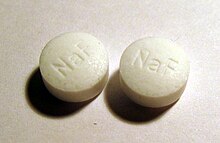
Back علاج بالفلورايد Arabic Fluoridierung German Terapia de fluoruro Spanish درمان با فلوراید Persian Thérapie au fluor French טיפול בפלואוריד HE Ֆտորիդային բուժում Armenian フッ化物療法 Japanese ଫ୍ଲୋରାଇଡ ଚିକିତ୍ସା OR Terapia de fluoreto Portuguese
 Sodium fluoride tablets.
Fluoride tablets are the least preferred fluoride therapy (topical therapies are more effective). | |
| Clinical data | |
|---|---|
| Trade names | OrthoWash, PerioMed, others |
| AHFS/Drugs.com | Monograph |
| License data | |
| Routes of administration | By mouth |
| ATC code | |
| Legal status | |
| Legal status | |
| Identifiers | |
| CAS Number | |
| PubChem CID | |
| DrugBank | |
| ChemSpider | |
| UNII | |
| KEGG | |
| ChEBI | |
| Chemical and physical data | |
| Formula | FNa |
| Molar mass | 41.98817244 g·mol−1 |
| 3D model (JSmol) | |
| |
| |
Fluoride therapy is the use of fluoride for medical purposes.[2] Fluoride supplements are recommended to prevent tooth decay in children older than six months in areas where the drinking water is low in fluoride.[3] It is typically used as a liquid, pill, or paste by mouth.[4] Fluoride has also been used to treat a number of bone diseases.[5]
Relatively high ingestion of fluoride by babies and children may result in white marks on the teeth known as fluorosis.[4] Excessive ingestion by babies and children can result in severe dental fluorosis, indicated by a brown or yellow coloring, weakening and brittleness of the teeth, or in severe cases, acute toxicity. Fluoride therapy typically uses the sodium fluoride form, though stannous fluoride may also be used.[4][5] Fluoride decreases breakdown of teeth by acids, promotes remineralisation, and decreases the activity of bacteria.[5] Fluoride works primarily through direct contact with teeth.[3][5]
Fluoride came into use to prevent tooth decay in the 1940s.[6] Fluoride is on the World Health Organization's List of Essential Medicines.[7] In 2021, it was the 291st most commonly prescribed medication in the United States, with more than 600,000 prescriptions.[8][9]
- ^ Mosby's Review Questions for the National Board Dental Hygiene Examination. Elsevier Health Sciences. 2013. p. 231. ISBN 978-0-323-22631-8. Archived from the original on 18 September 2017.
- ^ Weiner ER (2008). Applications of Environmental Aquatic Chemistry: A Practical Guide (2nd ed.). CRC Press. p. 389. ISBN 978-1-4200-0837-1. Archived from the original on 18 September 2017.
- ^ a b World Health Organization (2009). Stuart MC, Kouimtzi M, Hill SR (eds.). WHO Model Formulary 2008. World Health Organization. pp. 501–502. hdl:10665/44053. ISBN 978-92-4-154765-9.
- ^ a b c British National Formulary (BNF) 69 (69th ed.). British Medical Association. 2015. pp. 699–700. ISBN 978-0-85711-156-2.
- ^ a b c d "Fluorides". The American Society of Health-System Pharmacists. Archived from the original on 3 June 2016. Retrieved 8 January 2017.
- ^ Murray JJ, Nunn JH, Steele JG (2003). The Prevention of Oral Disease. OUP Oxford. p. 53. ISBN 978-0-19-263279-1. Archived from the original on 18 September 2017.
- ^ World Health Organization (2021). World Health Organization model list of essential medicines: 22nd list (2021). Geneva: World Health Organization. hdl:10665/345533. WHO/MHP/HPS/EML/2021.02.
- ^ "The Top 300 of 2021". ClinCalc. Archived from the original on 15 January 2024. Retrieved 14 January 2024.
- ^ "Sodium Fluoride - Drug Usage Statistics". ClinCalc. Retrieved 14 January 2024.
© MMXXIII Rich X Search. We shall prevail. All rights reserved. Rich X Search